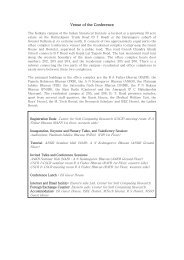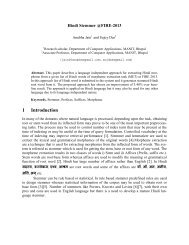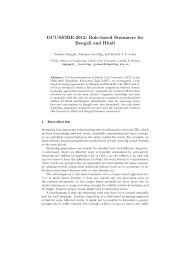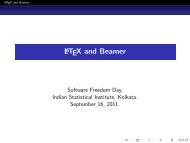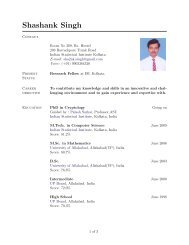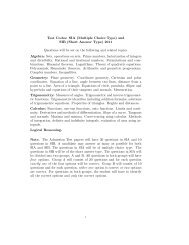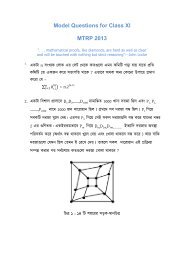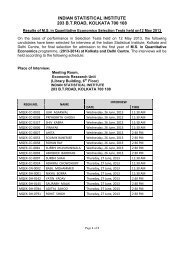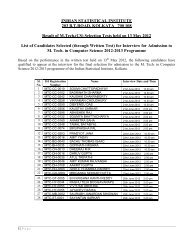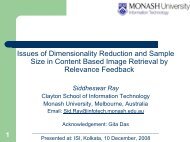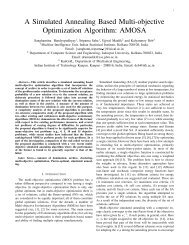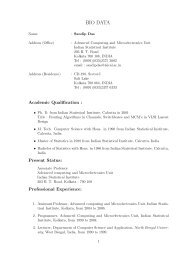Test Codes: SIA (Multiple-choice Type) and SIB (Short Answer Type ...
Test Codes: SIA (Multiple-choice Type) and SIB (Short Answer Type ...
Test Codes: SIA (Multiple-choice Type) and SIB (Short Answer Type ...
- No tags were found...
You also want an ePaper? Increase the reach of your titles
YUMPU automatically turns print PDFs into web optimized ePapers that Google loves.
<strong>Test</strong> <strong>Codes</strong>: <strong>SIA</strong> (<strong>Multiple</strong>-<strong>choice</strong> <strong>Type</strong>) <strong>and</strong><strong>SIB</strong> (<strong>Short</strong> <strong>Answer</strong> <strong>Type</strong>) 2009Questions will be set on the following <strong>and</strong> related topics.Algebra: Sets, operations on sets. Prime numbers, factorization of integers<strong>and</strong> divisibility. Rational <strong>and</strong> irrational numbers. Permutations <strong>and</strong> combinations.Binomial theorem. Logarithms. Theory of quadratic equations.Polynomials <strong>and</strong> remainder theorem. Arithmetic, geometric <strong>and</strong> harmonicprogressions. Complex numbers. Algebraic inequalities.Geometry: Plane geometry of class X level. Geometry of 2 dimensionswith Cartesian <strong>and</strong> polar coordinates. Concept of a locus. Equation of aline, angle between two lines, distance from a point to a line. Area of atriangle. Equations of circle, parabola, ellipse <strong>and</strong> hyperbola <strong>and</strong> equationsof their tangents <strong>and</strong> normals. Mensuration.Trigonometry: Measures of angles. Trigonometric <strong>and</strong> inverse trigonometricfunctions. Trigonometric identities including addition formulæ, solutionsof trigonometric equations. Properties of triangles. Heights <strong>and</strong> distances.Calculus: Functions, one-one functions, onto functions. Limits <strong>and</strong> continuity.Derivatives <strong>and</strong> methods of differentiation. Slope of a curve. Tangents<strong>and</strong> normals. Maxima <strong>and</strong> minima. Curve-tracing using calculus. Methodsof integration, definite <strong>and</strong> indefinite integrals, evaluation of area using integrals.Logical Reasoning.Note. The actual selection paper will have 30 questions in <strong>SIA</strong> <strong>and</strong> 10questions in <strong>SIB</strong>. The questions in <strong>SIA</strong> will be multiple <strong>choice</strong>-type. Thequestions in <strong>SIB</strong> will be short answer-type. The questions in <strong>SIA</strong> will bedivided into two groups, A <strong>and</strong> B. All questions in both the groups will have4 options. However, Group A will consist of 20 questions <strong>and</strong> exactly oneoption will be correct. Group B will consist of 10 questions <strong>and</strong> each questionwill have either one or two correct options. In either case, the student willhave to identify all the correct options <strong>and</strong> only the correct options in orderto get credit for that question.1
Sample Questions for <strong>SIA</strong>Group AEach of the following questions have exactly one correct option <strong>and</strong> youhave to identify it.1. The last digit of (2137) 754 is(A) 1. (B) 3. (C) 7. (D) 9.2. The sum of all distinct four digit numbers that can be formed usingthe digits 1, 2, 3, 4, <strong>and</strong> 5, each digit appearing at most once, is(A) 399900. (B) 399960. (C) 390000. (D) 360000.3. The coefficient of a 3 b 4 c 5 in the expansion of (bc + ca + ab) 6 is( )(12!6 6(A)3!4!5! . (B) 3!. (C) 33. (D) 3 .33)4. If log 10 x = 10 log 100 4 then x equals(A) 4 10 . (B) 100. (C) log 10 4. (D) none of the above.5. Let ABCD be a unit square. Four points E, F , G <strong>and</strong> H are chosenon the sides AB, BC, CD <strong>and</strong> DA respectively. The lengths of thesides of the quadrilateral EF GH are α, β, γ <strong>and</strong> δ. Which of thefollowing is always true?(A) 1 ≤ α 2 + β 2 + γ 2 + δ 2 ≤ 2 √ 2.(B) 2 √ 2 ≤ α 2 + β 2 + γ 2 + δ 2 ≤ 4 √ 2.(C) 2 ≤ α 2 + β 2 + γ 2 + δ 2 ≤ 4.(D) √ 2 ≤ α 2 + β 2 + γ 2 + δ 2 ≤ 2 + √ 2.6. The set of all real numbers x satisfying the inequality x 3 (x+1)(x−2) >0 is(A) the interval (2, ∞).(B) the interval (0, ∞).(C) the interval (−1, ∞).(D) none of the above.7. The sides of a triangle are given to be x 2 + x + 1, 2x + 1 <strong>and</strong> x 2 − 1.Then the largest of the three angles of the triangle is( ) x(A) 75 ◦ . (B)x + 1 π radians. (C) 120 ◦ . (D) 135 ◦ .2
(A) f n (x).(B) f n (x)f n−1 (x).(C) f n (x)f n−1 (x) · · · f 1 (x). (D) f n+1 (x)f n (x) · · · f 1 (x)e x .15. If the functionf(x) =is continuous at x = 0, then{x 2 −2x+Asin xif x ≠ 0B if x = 0(A) A = 0, B = 0. (B) A = 0, B = −2.(C) A = 1, B = 1. (D) A = 1, B = 0.16. A truck is to be driven 300 kilometres (kms.) on a highway at a constantspeed of x kms. per hour. Speed rules of the highway requirethat 30 ≤ x ≤ 60. The fuel costs ten rupees per litre <strong>and</strong> is consumedat the rate 2 + (x 2 /600) litres per hour. The wages of the driver are200 rupees per hour. The most economical speed (in kms. per hour)to drive the truck is(A) 30. (B) 60. (C) 30 √ 3.3. (D) 20 √ 33.17. If b =∫ 10e t ∫ at + 1 dt thena−1e −tdt ist − a − 1(A) be a . (B) be −a . (C) −be −a . (D) −be a .18. In the triangle ABC, the angle ∠BAC is a root of the equation√3 cos x + sin x = 1/2.Then the triangle ABC is(A) obtuse angled.(C) acute angled but not equilateral.(B) right angled.(D) equilateral.19. The number of maps f from the set {1, 2, 3} into the set {1, 2, 3, 4, 5}such that f(i) ≤ f(j) whenever i < j is(A) 60. (B) 50. (C) 35. (D) 30.20. Let n be a positive integer. Consider a square S of side 2n units. DivideS into 4n 2 unit squares by drawing 2n − 1 horizontal <strong>and</strong> 2n − 1vertical lines one unit apart. A circle of diameter 2n−1 is drawn withits centre at the intersection of the two diagonals of the square S. Howmany of these unit squares contain a portion of the circumference ofthe circle?4
(A) 4n − 2. (B) 4n. (C) 8n − 4. (D) 8n − 2.21. A lantern is placed on the ground 100 feet away from a wall. A mansix feet tall is walking at a speed of 10 feet/second from the lanternto the nearest point on the wall. When he is midway between thelantern <strong>and</strong> the wall, the rate of change (in ft./sec.) in the length ofhis shadow is(A) 2.4. (B) 3. (C) 3.6. (D) 12.22. An isosceles triangle with base 6 cms. <strong>and</strong> base angles 30 ◦ each isinscribed in a circle. A second circle touches the first circle <strong>and</strong> alsotouches the base of the triangle at its midpoint. If the second circleis situated outside the triangle, then its radius (in cms.) is(A) 3 √ 3/2. (B) √ 3/2. (C) √ 3. (D) 4/ √ 3.23. Let n be a positive integer. Definef(x) = min{|x − 1|, |x − 2|, . . . , |x − n|}.Then(A)∫ n+10f(x)dx equals(n + 4). (B)4(n + 3). (C)4(n + 2). (D)2(n + 2).424. Let S = {1, 2, . . . , n}. The number of possible pairs of the form (A, B)with A ⊆ B for subsets A <strong>and</strong> B of S isn∑( )( )n n(A) 2 n . (B) 3 n . (C). (D) n!.k n − k25. Consider three boxes, each containing 10 balls labelled 1, 2, . . . , 10.Suppose one ball is drawn from each of the boxes. Denote by n i , thelabel of the ball drawn from the i-th box, i = 1, 2, 3. Then the numberof ways in which the balls can be chosen such that n 1 < n 2 < n 3 is(A) 120. (B) 130. (C) 150. (D) 160.k=026. The maximum of the areas of the isosceles triangles with base on thepositive x-axis <strong>and</strong> which lie below the curve y = e −x is:(A) 1/e. (B) 1. (C) 1/2. (D) e.5
27. Suppose a, b <strong>and</strong> n are positive integers, all greater than one. If a n +b nis prime, what can you say about n?(A) The integer n must be 2.(B) The integer n need not be 2, but must be a power of 2.(C) The integer n need not be a power of 2, but must be even.(D) None of the above is necessarily true.28. Water falls from a tap of circular cross section at the rate of 2 metres/sec<strong>and</strong> fills up a hemispherical bowl of inner diameter 0.9 metres.If the inner diameter of the tap is 0.01 metres, then the time neededto fill the bowl is(A) 40.5 minutes.(B) 81 minutes.(C) 60.75 minutes.(D) 20.25 minutes.29. The value of the integral∫ 5π/2e tan−1 (sin x)e tan−1 (sin x) + e dxtan−1 (cos x)equalsπ/2(A) 1. (B) π. (C) e. (D) none of these.30. The set of all solutions of the equation cos 2θ = sin θ+cos θ is given by(A) θ = 0.(B) θ = nπ + π 2, where n is any integer.(C) θ = 2nπ or θ = 2nπ − π 2 or θ = nπ − π 4, where n is any integer.(D) θ = 2nπ or θ = nπ + π 4, where n is any integer.31. For k ≥ 1, the value of( ( ) ( ) ( )n n + 1 n + 2n + k+ + + · · · +0)1 2kequals( n + k + 1(A)n + k( n + k + 1(C)n + 1). (B) (n + k + 1)). (D)( n + k + 132. The value of{ ( √ )} √ √ ]sin −1 cot[sin −1 1 5 2 81 − + cos −12 63 + sec−1 36n( ) n + k.n + 1).
is(A) 0. (B) π/6. (C) π/4. (D) π/2.33. Which of the following graphs represents the functionf(x) =∫ √ x0e −u2 /x du, for x > 0 <strong>and</strong> f(0) = 0?(A)(B)(C)(D)34. If a n =(1 + 1 ) ) 2 ( ) 3 ) n (1n 2 + 22n 2 1 + 32n 2 · · ·(1 + n2n 2 , thenislimn→∞ a−1/n2 n(A) 0. (B) 1. (C) e. (D) √ e/2.35. If f(x) = e x sin x, then d10dx 10 f(x) ∣∣∣x=0equals(A) 1. (B) −1. (C) 10. (D) 32.36. Consider a circle with centre O. Two chords AB <strong>and</strong> CD extended intersectat a point P outside the circle. If ∠AOC = 43 ◦ <strong>and</strong> ∠BP D =18 ◦ , then the value of ∠BOD is(A) 36 ◦ . (B) 29 ◦ . (C) 7 ◦ . (D) 25 ◦ .37. A box contains 10 red cards numbered 1, . . . , 10 <strong>and</strong> 10 black cardsnumbered 1, . . . , 10. In how many ways can we choose 10 out of the20 cards so that there are exactly 3 matches, where a match means ared card <strong>and</strong> a black card with the same number?7
( )( ( )( )10 7 10 7(A) 23 4)4 . (B) .3 4( )( )( )1010 14(C) 2 7 . (D).33 438. Let P be a point on the ellipse x 2 + 4y 2 = 4 which does not lie onthe axes. If the normal at the point P intersects the major <strong>and</strong> minoraxes at C <strong>and</strong> D respectively, then the ratio P C : P D equals(A) 2. (B) 1/2. (C) 4. (D) 1/4.39. The set of complex numbers z satisfying the equation(3 + 7i)z + (10 − 2i)¯z + 100 = 0represents, in the Arg<strong>and</strong> plane,(A) a straight line.(B) a pair of intersecting straight lines.(C) a pair of distinct parallel straight lines.(D) a point.40. The number of triplets (a, b, c) of integers such that a < b < c <strong>and</strong>a, b, c are sides of a triangle with perimeter 21 is(A) 7. (B) 8. (C) 11. (D) 12.41. Suppose a, b <strong>and</strong> c are three numbers in G.P. If the equationsax 2 + 2bx + c = 0 <strong>and</strong> dx 2 + 2ex + f = 0 have a common root, thenda , e b <strong>and</strong> f are inc(A) A.P. (B) G.P. (C) H.P. (D) none of the above.42. The number of solutions of the equation sin −1 x = 2 tan −1 x is(A) 1. (B) 2. (C) 3. (D) 5.43. Suppose ABCD is a quadrilateral such that ∠BAC = 50 ◦ , ∠CAD =60 ◦ , ∠CBD = 30 ◦ <strong>and</strong> ∠BDC = 25 ◦ . If E is the point of intersectionof AC <strong>and</strong> BD, then the value of ∠AEB is(A) 75 ◦ . (B) 85 ◦ . (C) 95 ◦ . (D) 110 ◦ .44. Let R be the set of all real numbers. The function f : R → R definedby f(x) = x 3 − 3x 2 + 6x − 5 is8
(A) one-to-one, but not onto.(C) onto, but not one-to-one.(B) one-to-one <strong>and</strong> onto.(D) neither one-to-one nor onto.45. Let L be the point (t, 2) <strong>and</strong> M be a point on the y-axis such thatLM has slope −t. Then the locus of the midpoint of LM, as t variesover all real values, is(A) y = 2 + 2x 2 . (B) y = 1 + x 2 .(C) y = 2 − 2x 2 . (D) y = 1 − x 2 .46. Suppose x, y ∈ (0, π/2) <strong>and</strong> x ≠ y. Which of the following statementsis true?(A) 2 sin(x + y) < sin 2x + sin 2y for all x, y.(B) 2 sin(x + y) > sin 2x + sin 2y for all x, y.(C) There exist x, y such that 2 sin(x + y) = sin 2x + sin 2y.(D) None of the above.47. A triangle ABC has a fixed base BC. If AB : AC = 1 : 2, then thelocus of the vertex A is(A) a circle whose centre is the midpoint of BC.(B) a circle whose centre is on the line BC but not the midpoint ofBC.(C) a straight line.(D) none of the above.48. Let N be a 50 digit number. All the digits except the 26th one fromthe right are 1. If N is divisible by 13, then the unknown digit is(A) 1. (B) 3. (C) 7. (D) 9.49. Suppose a < b. The maximum value of the integral∫ ba( )34 − x − x2 dxover all possible values of a <strong>and</strong> b is(A) 3/4. (B) 4/3. (C) 3/2. (D) 2/3.50. For any n ≥ 5, the value of 1 + 1 2 + 1 3 + · · · + 12 n lies between− 1(A) 0 <strong>and</strong> n/2. (B) n/2 <strong>and</strong> n.(C) n <strong>and</strong> 2n.(D) none of the above.9
51. Let ω denote a cube root of unity which is not equal to 1. Then thenumber of distinct elements in the set{(1 + ω + ω 2 + · · · + ω n ) m : m, n = 1, 2, 3, · · · }is(A) 4. (B) 5. (C) 7. (D) infinite.52. The value of the integral∫ 32dxlog e x(A) is less than 2. (B) is equal to 2.(C) lies in the interval (2, 3). (D) is greater than 3.53. For each positive integer n, define a function f n on [0, 1] as follows:⎧0, if x = 0,sin π2n , if 0 < x ≤ 1 n ,⎪⎨ sin 2π2n , if 1 n < x ≤ 2 n ,f n (x) =sin 3π2n , if 2 n < x ≤ 3 n ,.⎪⎩sin nπ2n ,n−1ifn < x ≤ 1.Then, the value of limn→∞∫ 10f n (x) dx is(A) π. (B) 1. (C) 1 π . (D) 2 π .54. In a win-or-lose game, the winner gets 2 points whereas the loser gets0. Six players A, B, C, D, E <strong>and</strong> F play each other in a preliminaryround from which the top three players move to the final round. Aftereach player has played four games, A has 6 points, B has 8 points <strong>and</strong>C has 4 points. It is also known that E won against F. In the next setof games D, E <strong>and</strong> F win their games against A, B <strong>and</strong> C respectively.If A, B <strong>and</strong> D move to the final round, the final scores of E <strong>and</strong> F are,respectively,(A) 4 <strong>and</strong> 2. (B) 2 <strong>and</strong> 4. (C) 2 <strong>and</strong> 2. (D) 4 <strong>and</strong> 4.10
55. The number of ways in which one can select six distinct integers fromthe set {1, 2, 3, · · · , 49}, such that no two consecutive integers are selected,is(A)( 496)− 5( ) 48. (B)5( ) ( ) ( )4325 44. (C) . (D) .66 6Group BEach of the following questions has either one or two correct options <strong>and</strong>you have to identify all the correct options.1. If positive numbers a, b, c, d are such that 1/a, 1/b, 1/c, 1/d are in arithmeticprogression then we always have(A) a + d ≥ b + c. (B) a + b ≥ c + d.(C) a + c ≥ b + d.(D) bc > ad.2. Let n > 3 be odd. Then(A) n 2 − 1 is always divisible by 16.(B) If n − 1 is a power of 2, then n 2 − 1 can be written as mq, wherem is a power of 2 <strong>and</strong> q is an odd integer.(C) n 2 − 1 is always divisible by 24, when n is a prime.(D) There is no value of n such that 2 57912 + 1 divides n 2 − 1.3. ABC is a right angled triangle with hypotenuse BC. Then(A) the vertex A, the circumcentre, the centroid, <strong>and</strong> the orthocentreof the triangle always lie on a straight line.(B) the vertex A, the orthocentre, the circumcentre, <strong>and</strong> the incentreof the triangle always lie on a straight line.(C) the vertex A, the circumcentre, <strong>and</strong> the centroid <strong>and</strong> the incentreof the triangle always lie on a straight line.(D) the circumcentre, the centroid, the incentre <strong>and</strong> the orthocentreof the triangle always lie on a straight line.4. Consider the function f(x) = e 2x − x 2 . Then(A) f(x) = 0 for some x < 0. (B) f(x) = 0 for some x > 0.(C) f(x) ≠ 0 for every x < 0. (D) f(x) ≠ 0 for every x > 0.5. Let Q be a quadrilateral such that two of its sides are of length a <strong>and</strong>two other sides are of length b. If the area of Q is maximized, then11
Statement 2: For each real t, f(t) = f(t + 2π) holds.(A) Statement 1 is TRUE <strong>and</strong> Statement 2 is also the CORRECTREASON for Statement 1.(B) Statement 1 is TRUE <strong>and</strong> Statement 2 is NOT the CORRECTREASON for Statement 1.(C) Statement 1 is TRUE <strong>and</strong> Statement 2 is FALSE.(D) Statement 1 is FALSE <strong>and</strong> Statement 2 is TRUE.11. Let a 1 = b 1 = 1, a 2 = 2, b 2 = 3, a n+1 = a n +b n , b n+1 = 2a n +b n . Then(A) b 2 n = 2a 2 n + 1, if n is odd.(B) b 2 n = 2a 2 n − 1, if n is odd.(C) lim n→∞b nan= √ 2 − 1. (D) lim n→∞b nan= √ 2.12. Let f(x) be any differentiable function such that f(x) = ∫ x0 g(y)dy<strong>and</strong> F (x) = ∫ x0 f(y)dy. Then ∫ b0 x2 f(x)dx equals(A) ∫ b0 2x[f(b) − f(x)]dx. (B) ∫ b02x[F (b) − F (x)]dx.(C) ∫ b b 3 −x 30 3g(x)dx. (D) ∫ ( )b b 30 3 − x2 g(x)dx.13. Let f be the function f(x) = cos x − 1 + x22 . Then(A) f(x 0 ) = 0 for some x 0 > 0.(B) f(x 0 ) = 0 for some x 0 < 0.(C) f(x) is an increasing function on the interval (−∞, 0] <strong>and</strong> decreasingon the interval [0, ∞).(D) f(x) is a decreasing function on the interval (−∞, 0] <strong>and</strong> increasingon the interval [0, ∞).14. Let P, Q, R <strong>and</strong> S be four statements such that if P is true then Q istrue, if Q is true then R is true <strong>and</strong> if S is true then at least one of Q<strong>and</strong> R is false. It then follows that(A) if S is false, then both Q <strong>and</strong> R are true.(B) if at least one of Q <strong>and</strong> R is true, then S is false.(C) if P is true, then S is false.(D) if S is true, then both P <strong>and</strong> Q are false.15. If cos B cos C + sin B sin C sin 2 A = 1, then △ABC is(A) isosceles, but not equilateral.(C) equilateral.(B) right angled.(D) scalene.13
16. Let1 2 + 2 2 + · · · + n 2α = limn→∞ n 3 ,Then(1 3 − 1 2 ) + (2 3 − 2 2 ) + · · · + (n 3 − n 2 )β = limn→∞n 4 .(A) α = β. (B) α < β. (C) 4α = 3β. (D) 3α = 4β.17. Let x 1 , x 2 , . . . , x 100 be hundred integers such that the sum of any fiveof them is 20. Then(A) the largest x i equals 7. (B) the smallest x i equals 3.(C) x 17 = x 83 . (D) the average of all the numbers is 4.18. Let x be a positive real number. Then(A) x 2 + π 2 + x 2π > xπ + (x + π)x π .(B) x π + π x > x 2π + π 2x .(C) xπ + (x + π)x π > x 2 + π 2 + x 2π .(D) x 3 + π 3 + x 3π > 3πx π+1 .19. If a, b <strong>and</strong> c are three sides of a triangle with perimeter 1, then whichof the following is/are always true?(A) (1 − a)(1 − b)(1 − c) ≤ 8abc. (B) (1 − a)(1 − b)(1 − c) ≤ 8/27.(C) bc + ca + ab ≤ 1/3. (D) bc + ca + ab ≥ 1/3.20. Let x be an irrational number. If a, b, c <strong>and</strong> d are rational numberssuch that ax + b is a rational number, which of the following must becx + dtrue?(A) ad = bc. (B) ac = bd. (C) ab = cd. (D) a = d = 0.21. Let z = x + iy be a complex number, which satisfies the equation(z + z)z = 2 + 4i. Then(A) y = ±2. (B) x = ±2. (C) x = ±3. (D) y = ±1.22. In the given figure(A) sin(A + B + C) = cos(D + E).(B) sin(A + B + C) = sin(D + E).(C) cos(A + B + C) = − sin(D + E).(D) cos(A + B + C) = − cos(D + E).14EDABC
23. Consider the sequence of positive integers 55, 111, 5555, 10101, 555555,1001001, . . . In this sequence(A) No even term in the sequence is a perfect square.(B) No odd term in the sequence is a perfect square.(C) Some even terms are perfect squares.(D) Some odd terms are perfect squares.24. Consider the function f(θ) = sin n θ + cos n θ, where n ≥ 3 is a positiveinteger. Then(A) f(θ) = 1 has no real solution in (0, π/2).(B) f(θ) = 1 has exactly one real solution in (0, π/2).(C) f(θ) = 1 has exactly two real solution in (0, π/2).(D) f(θ) = 1 has exactly two real solution in [0, π/2].25. Define S n = 1 2 · 34 · · · 2n−12n, where n is a positive integer. Then(A) S n < √ 14n+2for some n > 2. (B) S n < √ 12n+1for all n ≥ 2.(C) S n < √ 12n+5for all n ≥ 2. (D) S n > √ 14n+2for all n ≥ 2.26. The algebraic sum of the perpendicular distances from A (x 1 , y 1 ),B (x 2 , y 2 ), C (x 3 , y 3 ), to a line is zero. Then the line must passthrough the(A) orthocentre of △ABC.(C) incentre of △ABC.(B) centroid of △ABC.(D) circumcentre of △ABC.27. Which of the following is/are contained in the solution set of the equation4x 2 − 40[x] + 51 = 0, where x is a real number <strong>and</strong> [x] denotesthe greatest integer that is less than or equal to x?(A) 13/2 < x < 17/2. (B) 3/2 ≤ x ≤ 7/2.(C) x ≠ √ 29/2.(D) None of the above.28. Let abc be a three digit number in base 10 with a > c + 1. Letabc − cba = efg. Then(A) g = 8. (B) efg + gfe = 1089. (C) f = 9. (D) e = 1.29. If n 2 +19n+92 is a perfect square, then the possible values of n may be(A) -19. (B) -8. (C) -4. (D) -11.30. Let a, b <strong>and</strong> c be three real numbers. Then the equation 11x−c = 0 15x−a + 1x−b +
(A) always have real roots.(B) can have real or complex roots depending on the values of a, b<strong>and</strong> c.(C) always have real <strong>and</strong> equal roots.(D) always have real roots, which are not necessarily equal.31. Let X be the set {1, 2, 3, . . . , 10} <strong>and</strong> P the subset {1, 2, 3, 4, 5}. Thenumber of subsets Q of X such that(A) P ∩ Q = {3} is 1. (B) P ∩ Q = {3} is 2 4 .(C) P ∩ Q = {3} is 2 5 . (D) P ∩ Q = {3} is 2 9 .32. Suppose that the equations x 2 + bx + ca = 0 <strong>and</strong> x 2 + cx + ab = 0have exactly one common non-zero root. Then(A) a + b + c = 0.(B) the two roots which are not common must necessarily be real.(C) the two roots which are not common may not be real.(D) the two roots which are not common are either both real or bothnot real.33. Let tan(α−β+γ)tan(α+β−γ) = tan βtan γ . Then(A) sin(β − γ) = sin(α − β). (B) sin(α − γ) = sin(β − γ).(C) sin(β − γ) = 0. (D) sin 2α + sin 2β + sin 2γ = 0.34. Let K be the set of all points (x, y) such that |x| + |y| ≤ 1. Given apoint A in the plane, let F A be the point in K which is closest to A.Then the points A for which F A = (1, 0) are35. Let(A) all points A = (x, y) with x ≥ 1.(B) all points A = (x, y) with x ≥ y + 1 <strong>and</strong> x ≥ 1 − y.(C) all points A = (x, y) with x ≥ 1 <strong>and</strong> y = 0.(D) all points A = (x, y) with x ≥ 0 <strong>and</strong> y = 0.tan 3θtan θ= k. Then(A) k ∈ (1/3, 3). (B) k ∉ (1/3, 3).(C)sin 3θsin θ= 2kk−1 .sin 3θ(D)sin θ> 2kk−1 .16
Sample Questions for <strong>SIB</strong>1. How many natural numbers less than 10 8 are there, with sum of digitsequal to 7?2. Consider the functionlogf(x) = lim e (2 + x) − x 2n sin xn→∞ 1 + x 2ndefined for x > 0. Is f(x) continuous at x = 1? Justify your answer.Show that f(x) does not vanish anywhere in the interval 0 ≤ x ≤ π 2 .Indicate the points where f(x) changes sign.3. Suppose a is a complex number such thata 2 + a + 1 a + 1 a 2 + 1 = 0.If m is a positive integer, find the value ofa 2m + a m + 1a m + 1a 2m .4. Let f(u) be a continuous function <strong>and</strong>, for any real number u, let [u]denote the greatest integer less than or equal to u. Show that for anyx > 1,∫ x1[x]∑[u]([u] + 1)f(u)du = 2 ii=1∫ xif(u)du.5. Two intersecting circles are said to be orthogonal to each other if thetangents to the two circles at any point of intersection are perpendicularto each other. Show that every circle passing through the points(2, 0) <strong>and</strong> (−2, 0) is orthogonal to the circle x 2 + y 2 − 5x + 4 = 0.6. Show that there is exactly one value of x which satisfies the equation2 cos 2 (x 3 + x) = 2 x + 2 −x .7. An oil-pipe has to connect the oil-well O <strong>and</strong> the factory F , betweenwhich there is a river whose banks are parallel, <strong>and</strong> not perpendicularto the line joining O <strong>and</strong> F . The pipe must cross the river perpendicularto the banks. Find the position <strong>and</strong> nature of the shortest suchpipe <strong>and</strong> justify your answer.8. Let x = (x 1 , . . . , x n ) <strong>and</strong> y = (y 1 , . . . , y n ) where x 1 , · · · , x n , y 1 , · · · , y nare real numbers. We write x > y if either x 1 > y 1 or for some k,with 1 ≤ k ≤ n − 1, we have x 1 = y 1 , . . . , x k = y k , but x k+1 > y k+1 .Show that for u = (u 1 , . . . , u n ), v = (v 1 , . . . , v n ), w = (w 1 , . . . , w n )<strong>and</strong> z = (z 1 , . . . , z n ), if u > v <strong>and</strong> w > z, then u + w > v + z.17
9. For any positive integer n, let f(n) be the remainder obtained ondividing n by 9. For example, f(263) = 2.(a) Let n be a three-digit number <strong>and</strong> m be the sum of its digits.Show that f(m) = f(n).(b) Show that f(n 1 n 2 ) = f(f(n 1 ) · f(n 2 )) where n 1 , n 2 are any twopositive three-digit integers.10. Show that it is not possible to have a triangle with sides a, b <strong>and</strong> cwhose medians have lengths 2 3 a, 2 3 b <strong>and</strong> 4 5 c.11. LetP (x) = x n + a n−1 x n−1 + a n−2 x n−2 + · · · + a 1 x + a 0be a polynomial with integer coefficients, such that P (0) <strong>and</strong> P (1) areodd integers. Show that:(a) P (x) does not have any even integer as root.(b) P (x) does not have any odd integer as root.12. Let N = {1, 2, . . . , n} be a set of elements called voters. Let C ={S : S ⊆ N} be the set of all subsets of N. Members of C are calledcoalitions. Let f be a function from C to {0, 1}. A coalition S ⊆ Nis said to be winning if f(S) = 1; it is said to be a losing coalitionif f(S) = 0. A pair 〈N, f〉 as above is called a voting game if thefollowing conditions hold.(a) N is a winning coalition.(b) The empty set ∅ is a losing coalition.(c) If S is a winning coalition <strong>and</strong> S ⊆ S ′ , then S ′ is also winning.(d) If both S <strong>and</strong> S ′ are winning coalitions, then S ∩ S ′ ≠ ∅, i.e., S<strong>and</strong> S ′ have a common voter.Show that the maximum number of winning coalitions of a votinggame is 2 n−1 . Find a voting game for which the number of winningcoalitions is 2 n−1 .13. Suppose f is a real-valued differentiable function defined on [1, ∞)with f(1) = 1. Suppose, moreover, that f satisfies f ′ (x) = 1/(x 2 +f 2 (x)). Show that f(x) ≤ 1 + π/4 for every x ≥ 1.14. If the normal to the curve x 2/3 + y 2/3 = a 2/3 at some point makesan angle θ with the X-axis, show that the equation of the normal isy cos θ − x sin θ = a cos 2θ.15. Suppose that a is an irrational number.(a) If there is a real number b such that both (a+b) <strong>and</strong> ab are rationalnumbers, show that a is a quadratic surd. (a is a quadraticsurd if it is of the form r + √ s or r − √ s for some rationals r <strong>and</strong>s, where s is not the square of a rational number).(b) Show that there are two real numbers b 1 <strong>and</strong> b 2 such that18
(i) a + b 1 is rational but ab 1 is irrational.(ii) a + b 2 is irrational but ab 2 is rational. (Hint: Considerthe two cases, where a is a quadratic surd <strong>and</strong> a is not aquadratic surd, separately).16. Let A, B, <strong>and</strong> C be three points on a circle of radius 1.(a) Show that the area of the triangle ABC equals1(sin(2∠ABC) + sin(2∠BCA) + sin(2∠CAB)) .2(b) Suppose that the magnitude of ∠ABC is fixed. Then showthat the area of the triangle ABC is maximized when ∠BCA =∠CAB.(c) Hence or otherwise show that the area of the triangle ABC is themaximum when the triangle is equilateral.17. In the given figure, E is the midpoint of the arcABEC <strong>and</strong> ED is perpendicular to the chord BCat D. If the length of the chord AB is l 1 , <strong>and</strong> that ofBD is l 2 , determine the length of DC in terms of l 1<strong>and</strong> l 2 .18. (a) Let f(x) = x − xe −1/x , x > 0. Show that f(x) is an increasingfunction on (0, ∞), <strong>and</strong> lim x→∞ f(x) = 1.(b) Using part (a) <strong>and</strong> calculus, sketch the graphs of y = x−1, y = x,y = x + 1, <strong>and</strong> y = xe −1/|x| for −∞ < x < ∞ using the same X<strong>and</strong> Y axes.19. For any integer n greater than 1, show that( ) 2n2 n 2 n< < ∏n n−1i=0 (1 − i n ).20. Show that there exists a positive real number x ≠ 2 such that log 2 x =x/2. Hence obtain the set of real numbers c such thathas only one real solution.log 2 xx21. Find a four digit number M such that the number N = 4 × M hasthe following properties.(a) N is also a four digit number.(b) N has the same digits as in M but in the reverse order.22. Consider a function f on nonnegative integers such that f(0) = 1,f(1) = 0 <strong>and</strong> f(n) + f(n − 1) = nf(n − 1) + (n − 1)f(n − 2) for n ≥ 2.19= cBAEDC
Show thatf(n)n!=n∑ (−1) k.k!k=023. Of all triangles with a given perimeter, find the triangle with themaximum area. Justify your answer.24. A 40 feet high screen is put on a vertical wall 10 feet above your eyelevel.How far should you st<strong>and</strong> to maximize the angle subtended bythe screen (from top to bottom) at your eye?25. Study the derivatives of the functiony = √ x 3 − 4x<strong>and</strong> sketch its graph on the real line.26. Suppose P <strong>and</strong> Q are the centres of two disjoint circles C 1 <strong>and</strong> C 2respectively, such that P lies outside C 2 <strong>and</strong> Q lies outside C 1 . Twotangents are drawn from the point P to the circle C 2 , which intersectthe circle C 1 at points A <strong>and</strong> B. Similarly, two tangents are drawnfrom the point Q to the circle C 1 , which intersect the circle C 2 atpoints M <strong>and</strong> N. Show that AB = MN.27. Evaluate: limn→∞12n log ( 2nn).28. Consider the equation x 5 + x = 10. Show that(a) the equation has only one real root;(b) this root lies between 1 <strong>and</strong> 2;(c) this root must be irrational.29. In how many ways can you divide the set of eight numbers {2, 3, . . . , 9}into 4 pairs such that no pair of numbers has g.c.d. equal to 2?30. Suppose S is the set of all positive integers. For a, b ∈ S, definea ∗ b =l.c.m.(a, b)g.c.d.(a, b)For example, 8 ∗ 12 = 6.Show that exactly two of the following three properties are satisfied:(a) If a, b ∈ S then a ∗ b ∈ S.(b) (a ∗ b) ∗ c = a ∗ (b ∗ c) for all a, b, c ∈ S.(c) There exists an element i ∈ S such that a ∗ i = a for all a ∈ S.20



